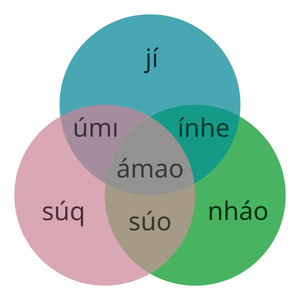Pronoun: Difference between revisions
No edit summary |
(shey -> she) |
||
| Line 53: | Line 53: | ||
| {{t|zé}} || it (latest [[object incorporating verb]] DP) | | {{t|zé}} || it (latest [[object incorporating verb]] DP) | ||
|- | |- | ||
| {{t|fúy}} || he/ | | {{t|fúy}} || he/she/they/it (same referent as latest pronoun) | ||
|- | |- | ||
| {{t|bóu}} || it (latest [[demonstrative]] noun phrase) | | {{t|bóu}} || it (latest [[demonstrative]] noun phrase) | ||
Revision as of 16:12, 5 July 2022
Toaq has relatively many pronouns. It makes distinctions that English does not:
- Clusivity: there are many words for “we” depending on who exactly is included.
- Exophora vs. anaphora: there are different pronouns for “things or people external to the text” (exophora) and for “references to earlier phrases” (anaphora).
- Animacy: there different pronouns for “he/she/it” for animals, objects, and ideas. There are even different anaphoric pronouns for different types of grammatical constructs.
| Pronoun | Meaning |
|---|---|
| jí | I, me |
| súq | you |
| nháo | he, she, they |
| súo | y'all (you and they) |
| múy | we (you and I) |
| míy | we (they and I) |
| máy | we (you, they, and I) |
| kóu* | it (inanimate object) |
| ráy* | it (abstract) |
| Pronoun | Meaning |
|---|---|
| hó | he/she/they (latest grammatically animate DP) |
| máq | it (latest grammatically inanimate DP) |
| hóq | it (latest grammatically abstract DP) |
| tá | it (latest adjective-like DP) |
| róu | it (latest |
| kúy | it (latest lu DP) |
| zé | it (latest object incorporating verb DP) |
| fúy | he/she/they/it (same referent as latest pronoun) |
| bóu | it (latest demonstrative noun phrase) |
| áq | itself/himself/herself/themselves (clause subject) |
| chéq | each other (reciprocal with clause subject) |
Notes
- All living animals have the pronoun nháo in Toaq, not just humans.
- The subject (first argument) of a clause only binds the anaphoric pronoun áq, so you cannot use hó, máq, hóq… to refer to it.
- For each pronoun, there's a verb crated by affixing -bo to it that means “___ is (that pronoun)'s”.
- For example, suqbo means “yours” and tabo means “its” (belonging to the referent of tá).
